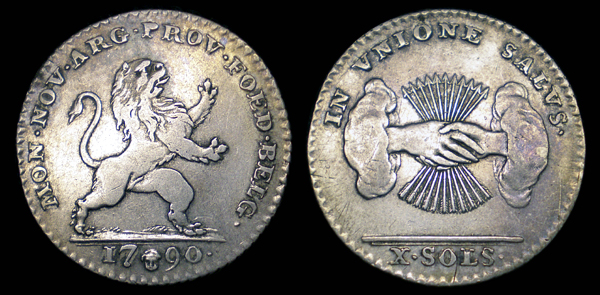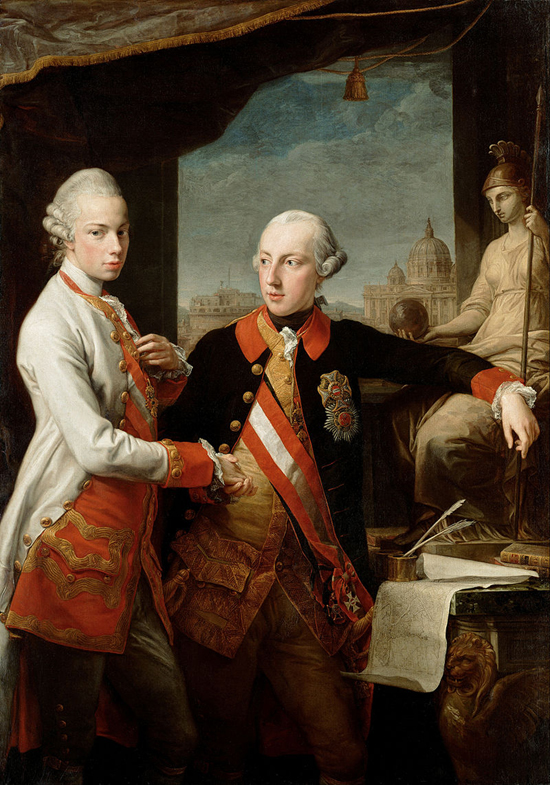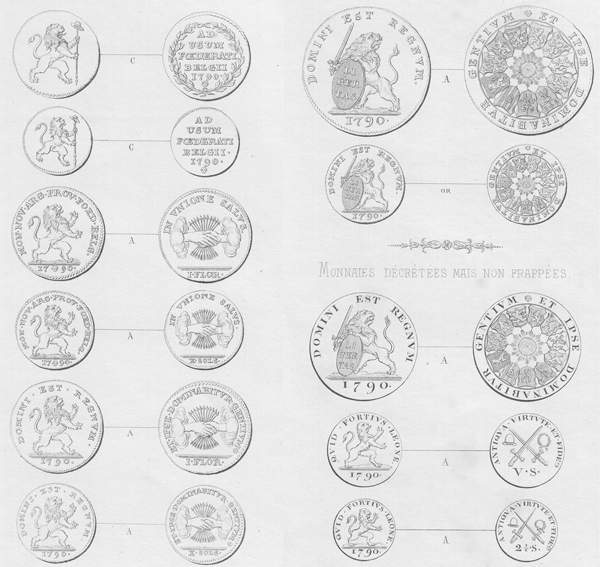
SILVER 10 SOLS - UNITED STATES OF BELGIUM
KM 635
Year: 1790
Obverse: Brabant lion standing right - MON NOV ARG PROV FOED BELG
Reverse: Two hands shaking, arrows behind - IN VNIONE SALVS / X-SOLS
Verenigde Belgische Staten - États-Belgiques-Unis - United States of Belgium / Insurrection Coinage / Belgian Revolution of 1789-1790 or Brabant Revolution, Revolt against Joseph II (HRE) / designed by Theodore Van Berckel, engraver at the Brussels Mint. The bundle of 11 arrows representing 11 provinces: East Flanders, West Flanders, Brabant, Hainault, Tournai, Namur, Luxembourg, Liège, Limburg, Antwerp and Mechelen. The obverse of this coin shows the Brabant lion standing (rampant) facing right with the inscription MON(eta) NOV(us) ARG(ent) PROV(inciae) FOED(eratus) BELG(ica) / New Silver Money of the Federated Provinces of Belgium. Below the lion is the date 1790 with the face of an angel in between the 7 and 9. This is the mint mark of the Brussels mint. The reverse of the coin depicts hands emerging from clouds shaking with 11 arrows behind for the eleven states that broke away from Austrian rule. Across the top are the words IN VNIONE SALVS / In Unity is Salvation. Below the hands and arrows is the denomination X SOLS. The lion is called the Brabant lion as The Duchy of Brabant had taken the lead in what became known as the Brabant Revolution, an insurrection against Emperor Joseph II, and afterwards dominated the resulting union. Thus the Lion of Brabant (a lion rampant or, armed and langued gules) became a symbol for the federation and remains the major part of the modern coat of arms of Belgium. So too is the motto which remains one of two official mottos of the modern state of Belgium. The coin stresses unity above all else.
The United States of Belgium was a short lived confederation of eleven states in the Southern Netherlands which formed in early January 1790 as a result of a general revolt (Brabant Revolution or Belgian Revolution of 1789-90) against the Holy Roman Empire under the rule of Joseph II. Joseph II of the house of Habsburg-Lorraine was little more than a silent junior partner when he succeeded his father, Francis I, as Holy Roman Emperor in 1765. His mother, Maria-Theresa of Austria, continued to be the true head of state as she was under his father's rule. Upon the death of his mother in 1780 he became sole ruler and he immediately began to issue waves of sweeping state, religious, and social reforms. Joseph was a liberal reformer who looked to secularize education and open it to greater numbers of the populace while taking steps to diminish the role of the clergy in state affairs. He reclaimed church lands and granted greater religious freedoms under the Patent of Tolerance of 1781. He took steps to unify the imperial states through bureaucratic reorganization and standardization of language and law. He also abolished the death penalty and sought to end serfdom. These actions were generally seen as flawed attempts at a grand experiment in enlightened rule although it might be said his intentions were noble. He stepped on many toes on his path to enlightenment and in the end his sweeping reforms managed only to cause further disunity. Increasingly discontent with successive waves of imperial reforms, some of the states openly rebelled or looked to secede. The Austrian Netherlands rioted after their protests and concerns were all but ignored. Riots turned to revolt and eventually a revolutionary militia was formed to resist imperial attempts to regain control. Both liberals and conservatives entered into a loose alliance with the church to form a 'committee of national liberation'. At the center of the movement was the conservative lawyer Hendrik Van der Noot who opposed the emperors reforms from day one. Joining him was an unlikely ally, liberal lawyer Jean-François Vonck. Vonck initially approved of the reforms but eventually joined with the opposition over the haphazard way in which the reforms were enacted. The former faction was known as the Statists, the later was known as the Vonckists. Revolutionaries under Van der Noot raised a small force and invaded Brabant defeating Austrian forces at the Battle of Turnhout in October of 1789. Thus began the Brabant Revolution in earnest. The empire was in turmoil. Joseph was rendered powerless to direct the affairs of state and military and he was labeled a heretic by the Catholic Church for championing religious tolerance. His health was failing, he soon found he had been abandoned by most family and friends and his directives were increasingly ignored. The Empire's central power structure was weakened and at odds, it was ill prepared to immediately and effectively counter the spreading revolutions.
By November of 1789, Austrian troops had withdrawn to their strongholds in Luxembourg and Antwerp, fleeing the advancing revolutionary troops and general anarchy. Van der Noot declared Brabant independent and soon after the other provinces of the Austrian Netherlands followed suit. On the strength of their early successes, the now free states formally unified on January 11, 1790 forming the Verenigde Nederlandse Staten (Dutch) / États-Belgiques-Unis (French) / The United States of Belgium (English). The Emperor Joseph, broken and virtually powerless, died on February 20, 1790. He left to Leopold II, his brother and successor, an almost completely disrupted state. He asked that his epitaph read: "Here lies Joseph II, who failed in all he undertook." Leopold and his brother were close and shared many of the same views. Like Joseph he was a reformer, a ruler from the school of Enlightened Despotism. Unlike his brother he was more moderate and less rash in his actions.
Leopold recognized Joseph's fatal flaws and distanced himself from his unpopular brother. Once in power he set to the daunting task of returning order to the empire. He worked to heal relations with other nations that had soured under his brother rule. He repealed many of his brothers reforms and quickly moved to put an end to the general revolt and recapture former imperial holdings in the Southern Netherlands. Knowing the Austrians would return, Van der Noot and the different factions in the new Belgian state worked to establish a functioning government. They established a governing body known as the Sovereign Congress and sought further legitimacy by gaining recognition of their new state by other nations. World recognition did not come, nor did unity for the fledgling nation. The factions that had joined against a common foe were, in essence, radically different in their politics. Once the common foe was no longer an imminent threat, those factions began to fight amongst themselves. The conservative Statists and progressive Vonckists factions were in constant conflict, bordering on civil war. Imperial troops marched into the Austrian Netherlands and took the city of Namur on October 24, 1790. Two days later, the province of West Flanders also submitted. Constant fighting between conservatives and progressives, the lack of unity, the lack of direction, and the lack of international confidence in the endeavor proved fatal for the new republic. By December of 1790, Leopold had fully regained the territory and the United States of Belgium was no more. The United States of Belgium did not last a full year but the Brabant Revolution had long-lasting repercussions. The internal discord between the supporters of Van der Noot and Vonck continued and was, in many ways, the basis of the two political movements that would dominate future Belgian politics. Forty years later the Southern Netherlands achieved independence and created the modern state of Belgium with a National congress. However they also appointed Leopold of Saxe-Coburg and Gotha as the first King of the Belgians, who in turn swore allegiance to the new constitution, and ruled as Leopold I. The Artistry of the Coin This coin was just one of several coins designed and engraved for the fledgling republic by the master engraver Theodore Victor van Berckel, some of which were never realized. Born in 1739 to Theodore Everard van Berckel, a master silversmith, Theodore began quite early learning the craft, training with his father when he was very young. The van Berckel family had long been in the craft of engraving and cutting dies as his grandfather Theodore Caspar van Berckel was a well known engraver as well.
After a time training with his father he was apprenticed to a family friend, the master engraver Johann Conrad Marmé. His time with Marmé lasted about a year after which Marmé moved to Utrecht to take a job at a provincial mint and Theodore moved back home to work in his fathers workshop producing mainly seals until 1760 when, he is mention as having produced a city hall medal, of which he would produce many. Theodore married Anna Maria Nouhuijis in 1763 and promptly moved to Rotterdam and became an independent die cutter producing many wedding and anniversary medals, more city council medals and various other medals for those who could pay him. With the death of the Graveur Genéréral at the Imperial mint in Brussels, Jacques Roëttiers, Van Berckel applied for the position but was rejected. However, after years without a replacement, a competition was held and when most of the other candidates dropped out, leaving only Berckel who finished the assigned task, he was soon after appointed Graveur Général at the Imperial Mint of the Austrian Netherlands in Brussels and promptly began producing dies for the coinage of the empress Maria Theresa. Once the empress passed away, he made medals for her son and successor Joseph II who visited the Netherlands in 1780. Many of the medals he produced were thrown to the population upon his arrival. During the civil strife and the revolution Berckel continued to go to work at the mint working on dies of Joseph II however once the Austrians had been fled the territory, the new government wasted little time commissioning him to create coinage for their new nation. Theodore quite quickly designed and put into production new copper and silver coinage. In all he produced 6 different coins for the short lived republic. Suffering no repercussion for his part in the revolution after the Austrians defeated the revolutionaries and retook the territory, he set to work on new dies for the new emperor Leopold II and, with the death of that emperor in 1792, he also produced all the dies for his successor Francis II. With the coming of French forces in 1794 there was a choice to be made, he could stay in the Netherlands or evacuate with the Austrians who had always treated him well. He chose the later.
After a time of uncertainty, Van Berckel was appointed to the office of chief engraver at the Mint in Vienna, however his position there was, unfortunately, largely administrative and all creative control remained in the hand of his predecessor Johann Nepomuk Würth who may have seen him as a way to throw of all the bothersome details of running a mint and spend his time engaged in the art of the coin. Van Berckel was embittered with his inability to change his situation. He objected but the Austrian government was pleased with his performance and wanted him to stay put and, to make matters worse, his wife passed away in 1802 leaving him even more distraught. Soon after he also fell ill, losing much of his sight from an infection and passed away in 1808. He had only produced one known set of dies during his time in Vienna. He is remembered today as one of the most talented and prolific coin engravers of the 18th century.
|






